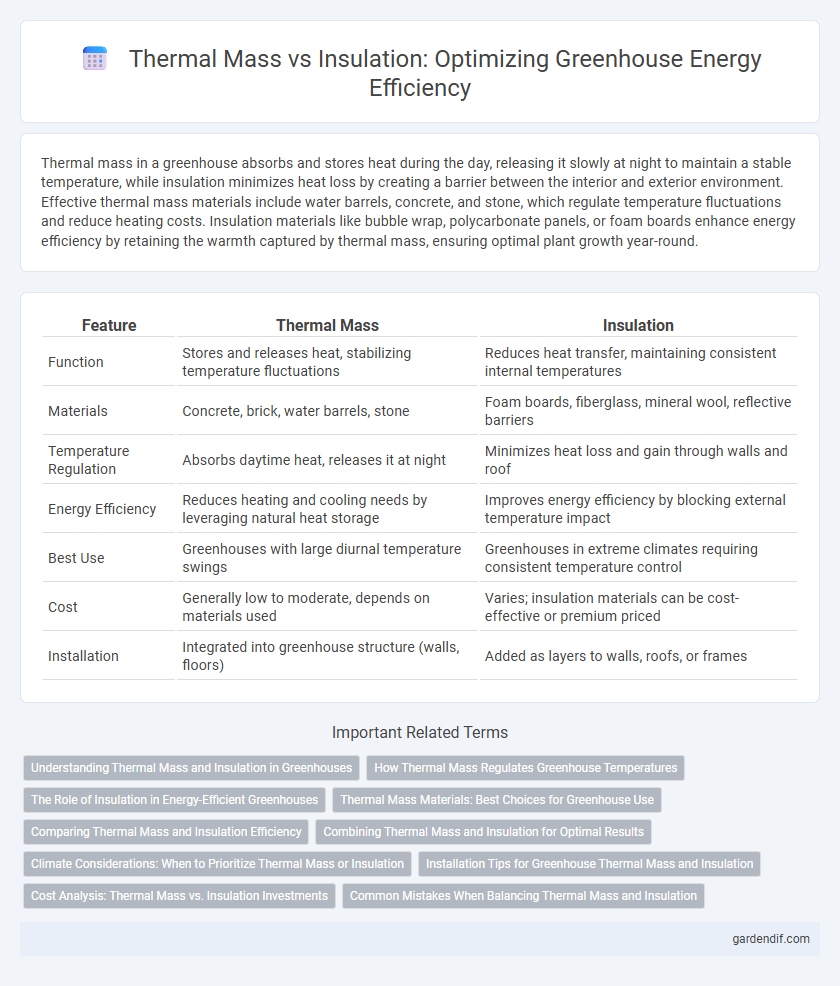
Thermal Mass vs Insulation Illustration
Thermal mass in a greenhouse absorbs and stores heat during the day, releasing it slowly at night to maintain a stable temperature, while insulation minimizes heat loss by creating a barrier between the interior and exterior environment. Effective thermal mass materials include water barrels, concrete, and stone, which regulate temperature fluctuations and reduce heating costs. Insulation materials like bubble wrap, polycarbonate panels, or foam boards enhance energy efficiency by retaining the warmth captured by thermal mass, ensuring optimal plant growth year-round.
Table of Comparison
| Feature | Thermal Mass | Insulation |
|---|---|---|
| Function | Stores and releases heat, stabilizing temperature fluctuations | Reduces heat transfer, maintaining consistent internal temperatures |
| Materials | Concrete, brick, water barrels, stone | Foam boards, fiberglass, mineral wool, reflective barriers |
| Temperature Regulation | Absorbs daytime heat, releases it at night | Minimizes heat loss and gain through walls and roof |
| Energy Efficiency | Reduces heating and cooling needs by leveraging natural heat storage | Improves energy efficiency by blocking external temperature impact |
| Best Use | Greenhouses with large diurnal temperature swings | Greenhouses in extreme climates requiring consistent temperature control |
| Cost | Generally low to moderate, depends on materials used | Varies; insulation materials can be cost-effective or premium priced |
| Installation | Integrated into greenhouse structure (walls, floors) | Added as layers to walls, roofs, or frames |
Understanding Thermal Mass and Insulation in Greenhouses
Thermal mass in greenhouses refers to materials like water barrels or concrete that absorb, store, and slowly release heat, stabilizing temperature fluctuations and promoting plant growth. Insulation minimizes heat loss by creating a barrier that reduces the transfer of heat between the inside and outside environments, crucial for maintaining consistent warmth during colder nights. Effective greenhouse climate control relies on balancing thermal mass and insulation to optimize energy efficiency and create an ideal environment for photosynthesis.
How Thermal Mass Regulates Greenhouse Temperatures
Thermal mass in greenhouses absorbs heat during the day and releases it slowly at night, stabilizing temperature fluctuations and creating an optimal growing environment. Materials such as water barrels, concrete, or stone are effective thermal masses due to their high heat capacity. This natural temperature regulation reduces the need for supplemental heating and cooling, enhancing energy efficiency in greenhouse operations.
The Role of Insulation in Energy-Efficient Greenhouses
Insulation plays a critical role in energy-efficient greenhouses by minimizing heat loss during cold periods and reducing heat gain during warmer times. High-performance materials, such as polycarbonate panels and double-glazed glass, enhance thermal retention and ensure a stable growing environment. Effective insulation reduces reliance on supplemental heating and cooling systems, leading to lower energy consumption and operational costs.
Thermal Mass Materials: Best Choices for Greenhouse Use
Thermal mass materials like concrete, brick, and water are highly effective for greenhouse use due to their ability to absorb, store, and slowly release heat, maintaining stable internal temperatures and reducing energy consumption. Among these, water barrels are popular for their high heat capacity and ease of integration, while concrete and brick walls provide structural support alongside thermal regulation. Optimal choices depend on greenhouse size and climate, aiming to balance heat retention and energy efficiency for healthier plant growth.
Comparing Thermal Mass and Insulation Efficiency
Thermal mass in greenhouses absorbs and stores heat during the day, releasing it slowly at night to stabilize temperature fluctuations, making it highly effective in climates with large diurnal temperature variations. Insulation reduces heat loss by creating a barrier to thermal transfer, optimizing energy efficiency and maintaining consistent internal warmth in colder environments. Comparing efficiency, thermal mass excels in heat storage and gradual release, while insulation is superior for minimizing heat escape and maintaining steady internal conditions.
Combining Thermal Mass and Insulation for Optimal Results
Combining thermal mass and insulation in greenhouse design maximizes temperature regulation by storing heat during the day and reducing heat loss at night. High thermal mass materials such as concrete or water absorb solar energy, while effective insulation minimizes thermal exchange with the external environment. This synergy enhances plant growth conditions, reduces energy costs, and stabilizes interior climates throughout seasonal temperature variations.
Climate Considerations: When to Prioritize Thermal Mass or Insulation
In cold climates, prioritizing insulation in greenhouses minimizes heat loss and maintains stable internal temperatures, reducing energy costs during winter. In contrast, thermal mass is more effective in moderate to warm climates where it absorbs excess heat during the day and releases it at night, smoothing temperature fluctuations. Climate-specific strategies balance thermal mass and insulation to optimize energy efficiency and plant growth.
Installation Tips for Greenhouse Thermal Mass and Insulation
When installing thermal mass in a greenhouse, position materials such as water barrels or concrete near plant beds to absorb and slowly release heat, enhancing temperature stability. Use high-R-value insulation materials like rigid foam panels on greenhouse walls and roof to minimize heat loss during cold nights. Ensure a tight seal around insulation edges and incorporate thermal mass on the sun-facing side for maximum solar gain and energy efficiency.
Cost Analysis: Thermal Mass vs. Insulation Investments
Investing in thermal mass materials like concrete or water tanks typically involves higher initial costs compared to insulation materials such as foam boards or fiberglass batts, but thermal mass reduces heating and cooling energy expenses by stabilizing indoor temperatures over time. Insulation investments provide quicker, more straightforward energy savings by minimizing heat transfer, often resulting in lower upfront costs and faster payback periods. A detailed cost analysis reveals that combining moderate thermal mass with high-quality insulation optimizes long-term energy efficiency and cost-effectiveness in greenhouse climate control.
Common Mistakes When Balancing Thermal Mass and Insulation
Neglecting the balance between thermal mass and insulation in a greenhouse can lead to inefficient temperature regulation, causing excessive heat loss at night or overheating during the day. Over-reliance on thermal mass without adequate insulation often results in poor energy conservation, while excessive insulation can prevent the effective use of thermal mass's heat storage capabilities. Common mistakes include insufficient insulation behind thermal mass walls and ignoring the greenhouse's orientation, which can compromise the overall thermal performance and plant growth environment.
Thermal Mass vs Insulation Infographic

 gardendif.com
gardendif.com